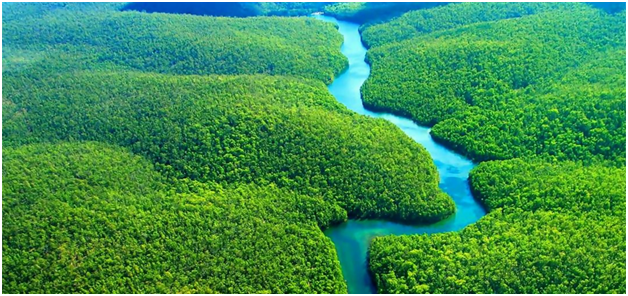
The Amazon Rainforest, often referred to as the “lungs of the Earth,” is one of the most biodiverse places on the planet. Spanning across nine countries in South America, the Amazon covers a vast area of approximately 5.5 million square kilometers (2.1 million square miles). The Peruvian section of the Amazon is home to unique wildlife, lush vegetation, and indigenous cultures, making it a popular destination for ecotourism. With its dense jungles, winding rivers, and rich ecosystems, the Amazon Rainforest offers a once-in-a-lifetime adventure for those looking to explore its natural wonders.
Top Attractions in the Peruvian Amazon
1. Puerto Maldonado
Puerto Maldonado is the gateway to the Peruvian Amazon and one of the most popular places to begin an Amazon adventure. The town is situated on the banks of the Madre de Dios River and offers easy access to a variety of jungle lodges, wildlife reserves, and adventure tours.
- Madre de Dios River: Visitors can take boat tours along the river, where they may spot wildlife such as capybaras, caimans, and colorful birds.
- Bahuaja-Sonene National Park: This park is home to a variety of ecosystems, from tropical rainforests to wetlands, and is one of the most biodiverse places in the world.
2. Tambopata National Reserve
Tambopata National Reserve is located in the Madre de Dios region and is known for its incredible biodiversity, pristine ecosystems, and indigenous communities. The reserve is a popular destination for wildlife enthusiasts and nature lovers.
- Macaw Clay Licks: One of the highlights of Tambopata is the chance to visit the macaw clay licks, where thousands of vibrant macaws gather to eat the mineral-rich clay.
- Wildlife Watching: The reserve is home to an incredible variety of animals, including jaguars, tapirs, giant river otters, and over 600 species of birds.
3. Manu National Park
Manu National Park is a UNESCO World Heritage site and one of the most biodiverse places in the world. The park is home to over 15,000 plant species, 1,000 bird species, and hundreds of mammals, reptiles, and amphibians.
- Biodiversity: Manu is renowned for its rich diversity, making it a paradise for wildlife photographers and ecotourists.
- Cultural Experiences: The park is also home to several indigenous communities, offering visitors the opportunity to learn about traditional ways of life.
4. Iquitos and the Amazon River
Iquitos is the largest city in the Peruvian Amazon and an excellent base for exploring the Amazon River and surrounding rainforests. From Iquitos, travelers can take boat trips to remote villages, wildlife reserves, and indigenous communities.
- Amazon River Cruise: A river cruise along the Amazon River is a must-do activity, offering the chance to explore the river’s tributaries, spot wildlife, and interact with local communities.
- Belen Market: The Belen Market in Iquitos is famous for its wide array of exotic fruits, fish, and medicinal plants used by indigenous peoples.
5. Pacaya-Samiria National Reserve
Located in the Loreto region, Pacaya-Samiria is the largest protected area in Peru’s Amazon. This vast reserve is known for its wetland ecosystems, which attract an abundance of wildlife, including endangered species.
- Wildlife Safari: Visitors can take guided boat tours to spot wildlife such as pink dolphins, monkeys, sloths, and a variety of bird species.
- Eco-Lodges: Several eco-lodges are located within or near the reserve, providing a sustainable way to experience the Amazon while supporting local communities.
Activities in the Amazon Rainforest
- Wildlife Watching: The Amazon is teeming with wildlife, and one of the most popular activities is to go on wildlife safaris to spot exotic animals like jaguars, monkeys, and birds.
- Canopy Walks: Many jungle lodges offer canopy walks, which allow visitors to walk above the rainforest floor on elevated platforms to observe the wildlife and plant life from a different perspective.
- River Cruises: Exploring the Amazon River by boat is one of the best ways to experience the rainforest. Visitors can take day trips or longer cruises to navigate the river and discover hidden corners of the jungle.
- Cultural Tours: The Amazon is home to several indigenous communities. Visitors can learn about traditional ways of life, medicinal plants, and local customs through guided tours led by indigenous guides.
- Fishing and Piranha Hunting: Adventurous travelers can try their hand at fishing in the Amazon River, including catching piranhas, which are famous for their sharp teeth and aggressive feeding habits.
Gastronomy in the Amazon
The Amazon offers a unique gastronomic experience, with many dishes made from locally sourced ingredients like fish, fruits, and roots.
- Ceviche de Paiche: A traditional Amazonian dish made with fresh fish from the Amazon River, marinated in citrus and served with rice and sweet potatoes.
- Tacacho con Cecina: A typical dish of the Peruvian Amazon made with mashed plantains, pork, and rice.
- Aguajina: A refreshing drink made from aguaje, a tropical fruit native to the Amazon Rainforest.
- Juices and Smoothies: Amazonian fruit juices are popular, made from fruits like camu-camu, maracuya (passion fruit), and guanabana (soursop).
Best Time to Visit the Amazon
The best time to visit the Amazon is during the dry season, which typically lasts from May to October. During these months, the weather is relatively dry, and the water levels in the rivers are lower, making it easier to access remote areas of the rainforest. The rainy season, from November to April, brings higher water levels, which can sometimes make certain areas more difficult to reach but can also create more lush and vibrant landscapes.
Practical Tips for Visiting the Amazon
- Mosquito Protection: The Amazon is home to many insects, including mosquitoes, so be sure to bring insect repellent and wear long sleeves and pants to protect yourself.
- Vaccinations: Check with your doctor before traveling to ensure you have the necessary vaccinations, such as those for yellow fever and malaria.
- Weather: The Amazon can be hot and humid, so pack lightweight, breathable clothing. Don’t forget to bring a rain poncho or jacket, as showers are common in the rainforest.
- Cash: While major towns like Iquitos and Puerto Maldonado have ATMs, it’s a good idea to carry enough cash for smaller towns and lodges in remote areas.
Accommodation in the Amazon
The Peruvian Amazon offers a range of accommodation options, from luxury eco-lodges with all the amenities to basic jungle huts for the more adventurous traveler. Many lodges and resorts are situated in remote areas and offer all-inclusive packages that include tours, meals, and activities.
Find accommodation options in the Amazon region on Booking.com.
Flight Information
The best way to reach the Peruvian Amazon is to fly into either Iquitos or Puerto Maldonado, both of which are easily accessible from Cusco or Lima. From there, you can take local flights, buses, or boat transfers to your chosen destination.
Book your flights to the Amazon with Skyscanner.
Conclusion
The Amazon Rainforest is an unparalleled destination for nature lovers and adventurers alike. From its diverse ecosystems and wildlife to its indigenous cultures and remote landscapes, the Amazon offers an immersive experience that can’t be found anywhere else. Whether you’re exploring the rainforest on a river cruise, hiking through the jungle, or learning about traditional customs from indigenous guides, a visit to the Amazon is sure to leave you with lasting memories. It’s an adventure into one of the most biodiverse places on Earth, and it will undoubtedly be one of the highlights of your travels through Peru.





